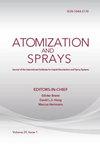Characterization of fully developed air-assisted spray unsteadiness using RP-3 jet fuel
IF 0.9
4区 工程技术
Q4 ENGINEERING, CHEMICAL
引用次数: 0
Abstract
The ideal spray theory of Edwards and Marx was utilized to investigate the dependence of fully developed intermittent air-assisted spray unsteadiness on operational conditions and fluid properties. Time series information of spray droplets was identified by Phase/Doppler Particle Analyzer and used for inter-particle arrival time statistics. Results demonstrated that spray unsteadiness along the spray axis and near the nozzle exit area is more significant than far-nozzle field and spray periphery. The unsteadiness on the spray axis shows a decreasing function with the fuel injection durations, while the increase of air injection duration significantly elongates the unstable region on the spray axis. The properties of test liquid fuels show a moderate effect on the stability of the air-assisted spray, which is most likely due to the effects of liquid properties on the atomization characteristics. Chi-square is generally the preferred method for quantifying the global spray unsteadiness when compared to the deviation of the first time gap of experimental and theoretical inter-particle time distribution. Unsteadiness results of high-velocity droplet spray stage are relatively distinct compared to droplet deceleration and suspension stages, which is due to the continuous energy input at the opening duration of the nozzle. This result further indicates that droplet velocity plays an important role in determining spray unsteadiness.利用RP-3喷气燃料充分发展的空气辅助喷射非定常特性
利用Edwards和Marx的理想喷雾理论,研究了完全发展的间歇气助喷雾不稳定性对操作条件和流体性质的依赖关系。采用相位/多普勒粒子分析仪识别雾滴的时间序列信息,用于粒子间到达时间统计。结果表明:沿喷流轴方向和喷流出口区域的不稳定性比远喷流场和喷流周边的不稳定性更显著;喷射轴上的不稳定性随喷油时间的增加呈减小的函数,而喷油时间的增加使喷射轴上的不稳定区域明显延长。试验液体燃料的性质对空气辅助喷雾的稳定性有一定的影响,这很可能是由于液体性质对雾化特性的影响。相对于实验和理论粒子间时间分布的首次间隙偏差,卡方通常是量化全局喷雾非定常的首选方法。与液滴减速和悬浮阶段相比,高速液滴喷射阶段的非定常结果相对明显,这是由于喷嘴开启期间持续的能量输入所致。这一结果进一步表明,液滴速度对雾滴的不稳定性起着重要的决定作用。
本文章由计算机程序翻译,如有差异,请以英文原文为准。
求助全文
约1分钟内获得全文
求助全文
来源期刊

Atomization and Sprays
工程技术-材料科学:综合
CiteScore
2.10
自引率
16.70%
发文量
54
审稿时长
1.7 months
期刊介绍:
The application and utilization of sprays is not new, and in modern society, it is extensive enough that almost every industry and household uses some form of sprays. What is new is an increasing scientific interest in atomization - the need to understand the physical structure of liquids under conditions of higher shear rates and interaction with gaseous flow. This need is being met with the publication of Atomization and Sprays, an authoritative, international journal presenting high quality research, applications, and review papers.
 求助内容:
求助内容: 应助结果提醒方式:
应助结果提醒方式:


